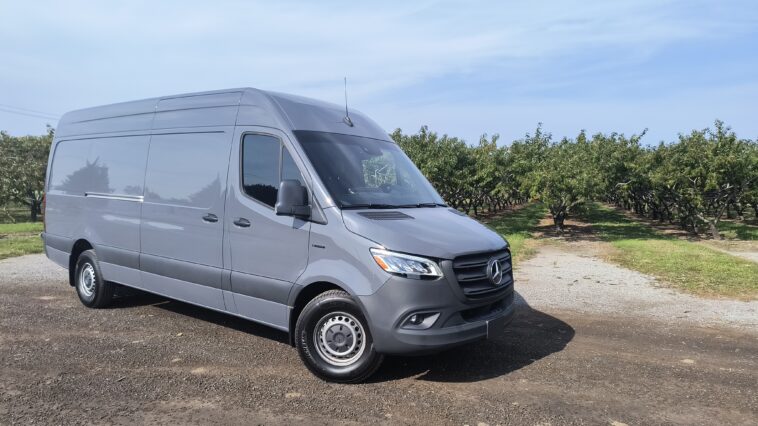 At a press launch for the updated Mercedes-Benz Sprinter in 2018, an electric version of the vehicle, the eSprinter was teased in Germany. At the time, the timeline for a North America release was not disclosed. Now, six years later, the official eSprinter has hit our shores, as a 2025 model
At a press launch for the updated Mercedes-Benz Sprinter in 2018, an electric version of the vehicle, the eSprinter was teased in Germany. At the time, the timeline for a North America release was not disclosed. Now, six years later, the official eSprinter has hit our shores, as a 2025 model
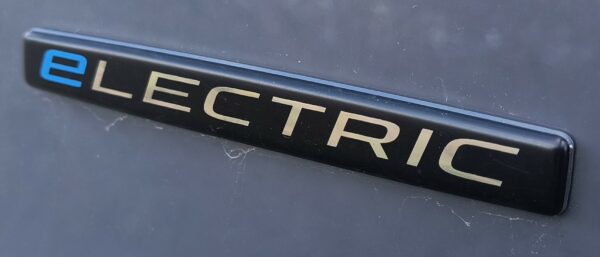 “The Mercedes-Benz eSprinter underlines our claim to ‘Lead in Electric’ and kicks off the next stage of our electrification strategy. Its versatility and flexibility make the new eSprinter the ideal vehicle for a wide range of applications,” says Mathias Geisen, head, Mercedes-Benz Vans.
“The Mercedes-Benz eSprinter underlines our claim to ‘Lead in Electric’ and kicks off the next stage of our electrification strategy. Its versatility and flexibility make the new eSprinter the ideal vehicle for a wide range of applications,” says Mathias Geisen, head, Mercedes-Benz Vans.
Many in the work truck industry are familiar with the Sprinter (either badged as a Mercedes-Benz or Freightliner). It has been a workhorse for many fleets, who continue to use them, and point to its many benefits, including the total cost of ownership. Now, those that have used a Sprinter and are looking at reducing their carbon footprint have an electric-only option.
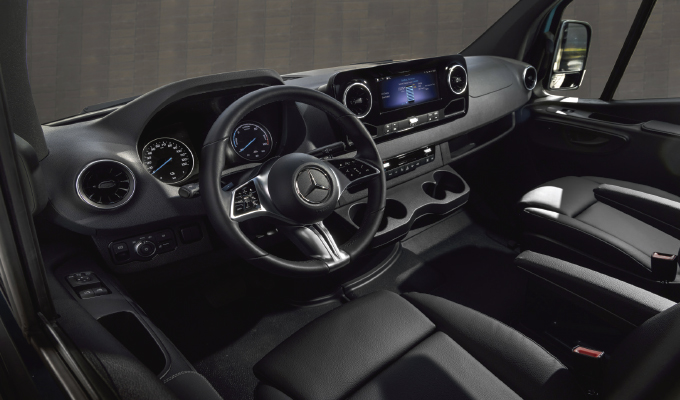
eSPRINTER AT A GLANCE
The eSprinter uses a permanent magnet synchronous motor that has power levels of 100 or 150 kilowatts with an output of 295 foot/pounds of torque. The battery is a Lithium iron phosphate and has a capacity of 113 kWh or a smaller 81 kWh option.
Charging times vary; the larger battery with a level 2 (240V) charger takes around 12 and a half hours to charge fully (10 hours with an 81-kWh battery), while using a DC Fast Charger (at 115kW) will charge the battery from 10 percent to 80 percent in 42 minutes (or in just over 30 minutes with an 81-kWh battery). The van has a standard rear-wheel drive configuration, a top speed of 75 miles per hour, and uses a single speed transmission.
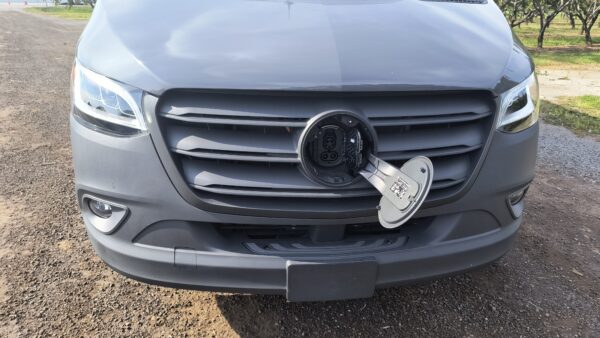 Three drive modes are available, comfort (full performance), economic (limits engine power), and maximum range (engine output is further reduced, and other features are also reduced). Along with the modes, regenerative braking also helps with efficiency. Five recuperation levels (D-, D, D+, D++, and D Auto) are available for drivers to get the level of efficiency they need.
Three drive modes are available, comfort (full performance), economic (limits engine power), and maximum range (engine output is further reduced, and other features are also reduced). Along with the modes, regenerative braking also helps with efficiency. Five recuperation levels (D-, D, D+, D++, and D Auto) are available for drivers to get the level of efficiency they need.
The 81-kWh battery offers a range of approximately 204 miles, while the larger 113 KWh option has a range of 297 miles. As with many electric vehicles, these numbers are variable based on load, weather and road conditions, driver behavior, and more.
“Daily delivery vehicles generally follow a fixed predictable route that is usually under 150 miles—making the eSprinter the perfect solution for last-mile-deliveries,” says Iain Forsyth, director of product management and marketing, Mercedes-Benz Vans USA. “However, businesses have unique needs when it comes to range, cargo volume and payload. It’s important to us to expand our product mix and provide options that tailor to their specific commercial purpose.”
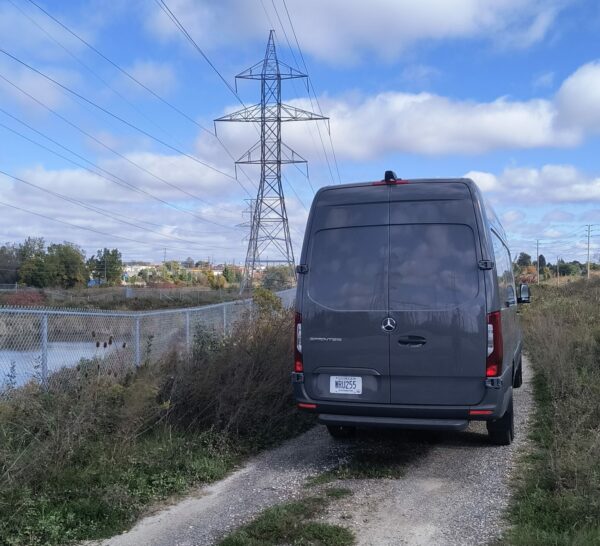
DIMENSIONS
Like its fuel-powered stablemate, the eSprinter with the larger 113 kWh battery is only available with a 280.4 inches length with a 170” wheelbase, is 92.3” wide with mirrors (79.5” without) and has a 107.1” height (high roof). Capacities include a max payload of 2,624 lbs, max GVWR of 9,370 lbs, max GCWR of 11,023 lbs, and a cargo volume of 488 cubic feet.
The model with a smaller 81 kWh battery is also available in standard roof, which is 95.6”, with an option for a smaller wheelbase of 144” (with a shorter length of 233.5”. Payload for the smaller battery model can go up to 3,516 lbs depending on how it is configured with cargo volume being between 319 and 488 cu/ft, again depending on configuration.
SAFETY
Safety is always top of mind for fleet managers and their drivers, and the eSprinter has many leading-edge features on tap. Active Brake Assist (also known as emergency braking) is standard, as is Blind Spot Assist and Attention Assist. Also available is Active Distance Assist, DISTRONIC, Traffic Sign Assist, Active Lane Keeping Assist, and a parking package with 360 degree camera.
Vans are notorious for having many blind spots, as a result, Mercedes-Benz offers an optional digital rearview mirror, which shows the back of the vehicle through a high-dynamic range camera. The mirror has light sensors and will adjust the brightness of the screen automatically.
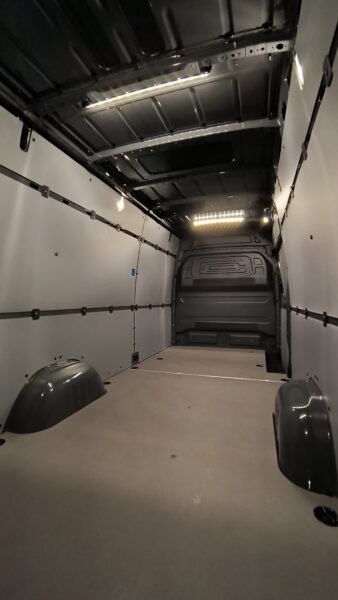
TOTAL COST OF OWNERSHIP
A service package is offered on the eSprinter, with any maintenance that is laid out in the service booklet and manufacturer’s specifications for the first four services in the first four years or up to 100,000 miles. Inspections of the high-voltage components and other vehicle parts and functions are also included. Additionally, a free battery certificate covers the component for eight years or up to 100,000 miles for material defects, and that the batteries are at or greater than 70 percent of initial capacity. Those who travel greater distances can get an optional battery certificate that can extend the distance by an additional 85,000 miles to a total of eight years or up to 185,000 miles total.
“With its versatility, a new generation of infotainment systems and enhanced safety- and assistance systems, the Sprinter continues to be the perfect overall system solution for a wide range of commercial transport and mobility requirements. Meanwhile, the new eSprinter impresses with its efficiency, range, and load volume. In doing so, it also underscores the Group’s claim to leadership in electric mobility in the commercially oriented segment,” says Andreas Zygan, head, Mercedes-Benz Vans Development.
About the Author
Mario Cywinski is the editor of Modern WorkTruck Solutions and has worked in the automotive industry for nearly 20 years, both as an automotive journalist and working for a local dealership. He is a member of the Automobile Journalist Association of Canada and has been a judge for the Canadian Truck King Challenge. He can be reached at mario@mwsmag.com.


